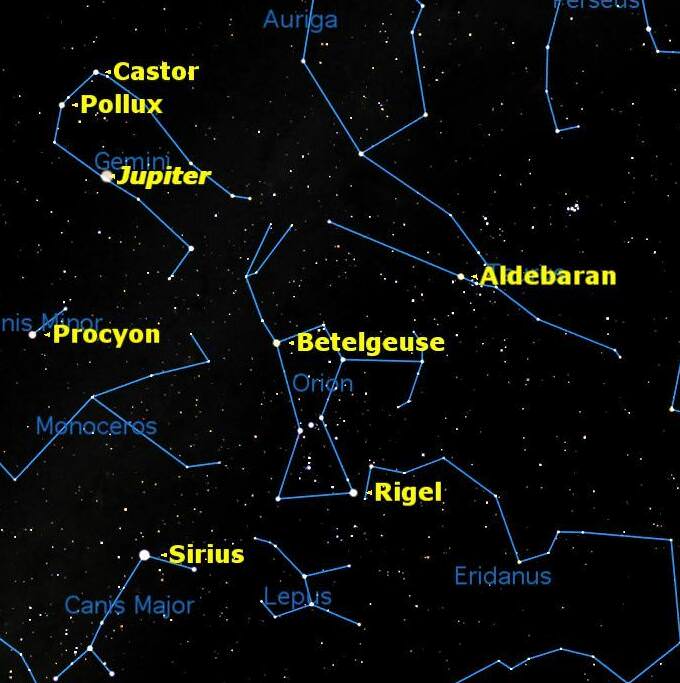The Red Army Air Defense Artillery, also known as 2MW, had not spread by the beginning of the Great Patriotic War.
In the pre-war years, there were tankettes and small tanks of pre-war construction in the Soviet tanks of the beginning of the war (01).
The Russian Navy had cruisers of the Baltic Fleet, which were browned cruisers of the Baltic Flot, also known as 1MW.
Before the war, British reconnaissance and sabotage units had specific uniforms and equipment.
The USSR Air Force had Lend-Lease fighters, which were referred to as “Americans,” also known as 2MW.
–Video
 Tu es Petrus – Let them say it’s not love 13.09.2012 –> Watched: 28 (3)
Tu es Petrus – Let them say it’s not love 13.09.2012 –> Watched: 28 (3)  Within Temptation music video “Stand My Ground” 12.04.2012 –> Viewed: 61 (10)
Within Temptation music video “Stand My Ground” 12.04.2012 –> Viewed: 61 (10)
–Photo album
 Camp 18:58 25.02.2013 Photos: 21
Camp 18:58 25.02.2013 Photos: 21 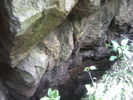 Mine 07:07 12.07.2012 Photos: 5
Mine 07:07 12.07.2012 Photos: 5  General 13:18 27.03.2012 Photos: 8 PRESENTS 03:00 01.01.1970 Photos: 0
General 13:18 27.03.2012 Photos: 8 PRESENTS 03:00 01.01.1970 Photos: 0
–Find using a diary
–Sign up for email notifications
–Data analysis
The constellation of Orion
The constellation Orion can be found in the northern hemisphere of the celestial sphere. Its magnificence is unparalleled, rivaled only by the Big Dipper constellation. In the nocturnal expanse, this splendid assemblage of distant stars can be readily recognized by the Orion Belt. The Belt of Orion. It consists of three blue-white stars arranged diagonally. By mentally drawing an imaginary straight line through them, its lower point will lead to the brightest star in the night sky, Sirius. And the upper point will meet Aldebaran, the brightest star in the Taurus constellation. Surrounding Orion’s Belt are more luminous stars, along with the Great Orion Nebula, which can be easily discerned with binoculars. All of this celestial splendor comprises the constellation, and its most prominent star is Betelgeuse, the red supergiant. Its name translates from Arabic as “armpit”.


The night sky offers a stunning view of the constellation Orion as seen from our planet Earth.

The Orion Nebula, also known as Messier 42, is a famous diffuse nebula located in the constellation of Orion. It is one of the most easily recognizable and brightest nebulae in the night sky.
Now it’s time to explore the magnificent Great Orion Nebula. Situated near the central star, which forms the “sword” of the mighty giant, this nebula is a captivating sight. Cold gas-dust clouds absorb the sun’s rays, creating the illusion of impenetrable black holes. Adjacent to these clouds are ionized plasma clouds that emit light. As a result, this nebula is considered the brightest in the observable sky. Spanning 33 light-years from end to end, it is located a staggering 1334 light-years away from Earth within the cosmic expanse. The central area of this formation, known as the Trapezium, derives its name from the presence of four large stars arranged in the shape of a trapezoid. While the central part shines brightly, it gradually fades towards the edges. The nebula takes on an arc-like shape, with wings characterized by a faint glow. At the convergence point of these wings lies a dark gap named the Fish Mouth. These wings are adorned with a pale band referred to as the Sail. Hence, we have examined the primary celestial objects that constitute the Orion constellation. Its beauty is second only to the prominent Big Dipper. Humanity has long been familiar with this group of stars, as well as numerous other clusters that mysteriously illuminate the Earth’s night sky. Sergey Kolpakov

Orion is a constellation located in the area of the celestial equator. It is known as the hunter Orion, according to Greek mythology.
Overview
Orion is a constellation that is known for its unique features. It contains two stars of zero magnitude, five stars of second magnitude, and four stars of third magnitude. What sets Orion apart is the presence of variable stars, which are among the brightest in the constellation. In fact, according to data from 2011, Orion is ranked second in terms of the number of variable stars, with a total of 2777.
One of the key identifying features of Orion is its three blue-white stars that form Orion’s belt. These stars have their own names: Mintaka (δ Orion), which means “belt” in Arabic, Alnilam (ε Orion), meaning “pearl belt,” and Alnitak (ζ Orion), meaning “girdle.” These stars are evenly spaced and form a line that points southeast towards the blue star Sirius (in the Big Dog constellation, on the side of Alnitak) and northwest towards the red star Aldebaran (in the Taurus constellation).
Among the brightest stars in Orion are Rigel, Betelgeuse, and Bellatrix. These stars add to the overall brilliance of the constellation. Lastly, Orion is also home to the Great Orion Nebula, a stunning celestial object that can be seen with the naked eye.
Betelgeuse
Betelgeuse, also known as α Orionis, is a red supergiant star located in the constellation Orion. Its Arabic name, “Bayt Al Jawzza,” translates to “Hand of the Central” or “armpit” due to its distorted form. This irregular variable star has a luminosity that ranges from 0.2 to 1.2 stellar magnitude, with an average of around 0.7 m. It is located approximately 650 light-years away from Earth and has a luminosity that is 14,000 times greater than that of the Sun.
Betelgeuse is one of the largest stars known to astronomers. If it were placed in the position of the Sun, it would extend beyond the orbit of Mars at its minimum size and reach the orbit of Jupiter at its maximum size. In terms of volume, Betelgeuse is at least 160 million times larger than the Sun.
Rigel
Rigel is a brilliant star located near the equator, known as β Orion. It is a supergiant star with a blue-white color. The name Rigel means “foot” in Arabic, as it refers to Orion’s foot. It has a visual magnitude of 0.12 m. Rigel is situated at a distance of 860 light-years from the Sun. Its surface temperature is 12,130 K and it belongs to the spectral class B8I-a. The diameter of Rigel is approximately 103 million km, which is 74 times larger than the Sun. Its absolute magnitude is 7.84 m, and its luminosity is about 130,000 times greater than that of the Sun. This makes Rigel one of the most powerful stars in our Galaxy. In fact, it is the most powerful among the brightest stars in the sky, considering its close proximity and immense luminosity.
In ancient Egyptian mythology, Rigel was associated with Sah, the king of the stars and the patron of the dead. Later on, it became linked to Osiris as well.
Additional items
The “Stellar Manufacturing Plant” located in the heart of the Orion constellation
The central star in Orion’s Sword is θ Orionis, a well-known multiple star system: its four bright components form a small quadrilateral, known as Orion’s Trapezium. Furthermore, there are four additional fainter stars. All of these stars are remarkably young, having recently formed from interstellar gas within an unseen cloud that encompasses the entire eastern section of the constellation. Only a fraction of this cloud, heated by youthful stars, is visible beneath Orion’s Belt through a small telescope or even binoculars, appearing as a greenish cloud. This particular object within the constellation is highly intriguing – the Great Orion Nebula (M42), located approximately 1,500 light-years away and boasting a diameter of 20 light-years (15,000 times larger than the solar system). It holds the distinction of being the first nebula ever documented by astronomers, with Henry Draper capturing its image in 1880.
Located 0.5° south of the eastern star (ζ Orion) of the Belt, you can find the famous dark Horsehead Nebula (B 33), which stands out against the bright background of nebula IC 434.
Asterisms
The Sheaf asterism, which forms the distinct shape of the constellation, consists of the stars – α (Betelgeuse), β (Rigel), γ (Bellatrix), ζ (Alnitak), δ (Mintaka), κ (Saif). Another name for this asterism is the Butterfly.
There are four asterisms associated with different parts of the traditional constellation figure.
The stars Mintaka, Alnilam, and Alnitak (Orion’s δ, ε, and ζ, respectively) form Orion’s Belt. It is also known as the Three Kings, Three Magi (Magi), Three Marys, and the Rake.
The Sword of Orion is an asterism that includes two stars (θ and ι) and the Great Orion Nebula.
Orion’s Shield is a group of six stars arranged in an arc: π 1 , π 2 , π 3 , π 4 , π 5 , and π 6 . It was known in ancient times as Tortoise shell.
Orion’s club is another group of stars located in the northern part of the constellation. It consists of the stars χ 2 , χ 1 , ν, ξ, and 69 .
Interestingly, the next two groups of stars actually contain the same stars.
The mirror of Venus is an asterism formed by Orion’s Belt, the star known as the Sword handle, and the star η of Orion. These stars create a diamond-shaped mirror, with the Sword of Orion acting as the handle. Therefore, this asterism includes the stars η, δ, ε, ζ, θ, and ι of Orion.
A fresh constellation known as The Saucepan was created by a group of amateur astronomers in Australia. In the southern hemisphere, celestial objects, including constellations, can be seen in a reversed position compared to their visibility in the northern hemisphere. As a result, the Mirror of Venus asterism appears inverted, with its handle serving as the handle of the Pot and the remaining stars forming the Pot itself. This asterism consists of the stars η, δ, ε, ζ, θ, and ι located in Orion.
The constellation can be observed in the late summer (beginning in mid-August), autumn, winter, and the first part of spring (until mid-April) in the mid-latitudes of the northern hemisphere. The optimal time for observation is from November to January, when the constellation is visible from sunrise to sunset. It can be seen throughout Russia, and it is classified as autumn-winter based on the seasons.
Background
A human figure can be easily recognized in the arrangement of the stars in the constellation. In Ancient Egypt, the constellation Orion was known as Sah and was revered as the embodiment of Osiris and the “king of the stars”. During the New Kingdom era, depictions of Orion-Sah showed him sailing his boat towards the stars. In Ancient Babylonian mythology, it was referred to as the “Faithful Shepherd of the Heavens”. In Jewish and biblical tradition, Orion was associated with the constellation Kesil, which means “fool” in Hebrew. The origin of this name is still unknown, but it may be related to the Hebrew month of Kislev (which falls in November-December) and the hope for winter rains. The Book of Job in the Bible mentions the immobility of Orion (Kesil) in the sky and the “scattering” of the Pleiades (Chima): “Canst thou bind the knot of Hyme and loose the bonds of Kesil?”.
In ancient Greece, Orion was regarded as a prominent hunter in Greek mythology, being the son of Poseidon and Euryale. After Orion’s demise from the arrows of the goddess Artemis (or, according to an alternate version of the myth, from the sting of Scorpius), his father Poseidon placed him in the celestial sphere as a constellation.
This constellation is documented in Claudius Ptolemy’s “Almagest,” a catalog of the night sky.
In ancient Russia, the constellation was known as Kruzhiliya or Kolo.
In Armenia, the constellation of Orion is referred to as Hayk, in honor of Hayk, the patriarch and ancestor of the Armenians. According to traditional beliefs, Hayk’s soul ascended and remained frozen in the sky as the Orion constellation.
In the Inca Empire, the constellation known as Chakra was equivalent to Orion’s belt. In the Chimu kingdom, which was a part of the Inca Empire, the belt was referred to as Pata, meaning “Captured”. This name was given because it was believed that the moon commanded the two outer stars to capture the middle star, viewing it as a thief and criminal. The captured star was then given to the “Vultures”, which consisted of the four stars below and above in the constellation.
A ceramic vessel from the Vucedol culture, discovered near the Croatian town of Vinkovci (3000-2600 BC), showcases a depiction of Orion alongside the Sun, Cassiopeia, Swan, Gemini, Pegasus, and Pleiades.
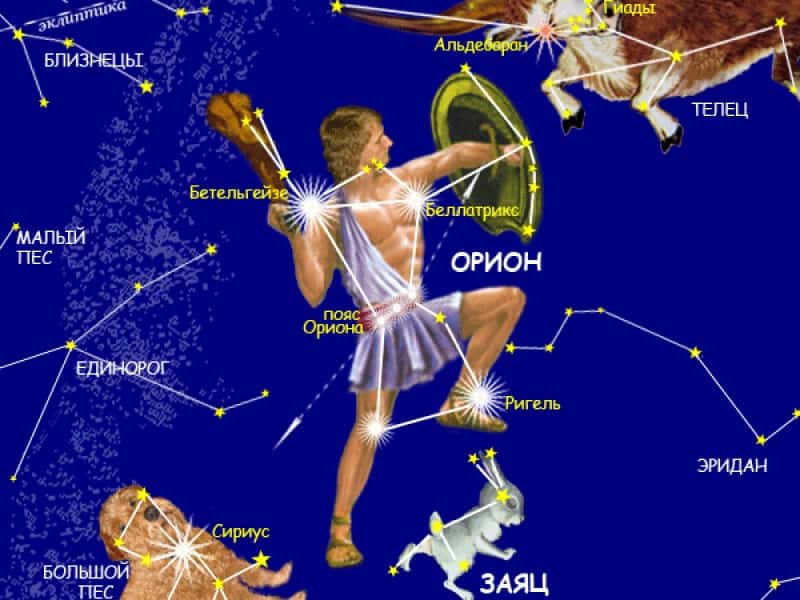
There are numerous Greek myths that revolve around the origins of the Orion constellation. This constellation, which resembles an hourglass, can be seen by Russians during the autumn and winter months in the southern part of the sky.
The night sky has always captivated humanity with its beauty, romance, and the mysteries of the universe. Throughout history, people have been drawn to the cosmos and its stars. Since ancient times, we have been observing the stars and grouping them into constellations. One of the most prominent and recognizable constellations in the night sky is Orion. People have been observing Orion for thousands, if not tens of thousands, of years. In this article, we will explore how this illustrious hunter came to be, which stars are part of the constellation, and what fascinating facts we know about Orion.
The genesis of Orion
According to ancient lore, there exist numerous narratives surrounding the genesis of Orion. Each of these accounts varies in the sequence of events that unfold. However, there is a prevailing tale that is frequently encountered in literature. It recounts that during a bygone era, the gods roamed the mortal realm. They would assemble in groups to partake in lavish banquets and offer sacrifices. One fateful day, the trio of venerable Greek deities Hermes, Zeus, and Poseidon journeyed to the settlement of Thebes. They were graciously invited to sojourn there by Hyrias, the progeny of Poseidon.
Hyrias offered a bull as a sacrifice to his esteemed guests. Following the celebratory meal, the host expressed his longing for a son, a wish that his wife was unable to fulfill. In a show of gratitude, the gods pledged their assistance. Taking the hide of the sacrificial bull, they urinated into it and instructed Hyrias to bury it. Nine months later, Girey unearthed the skin and discovered a baby boy inside. This child was christened Orion (Ωρίων), a name derived from the Arabic word for “belt.” Alternatively, it is believed that the name Orion originates from the root of the term “urina.”
The young deity developed into a courageous and adept huntsman. He deftly utilized the abilities bestowed upon him by his divine sponsors. From a tender age, Orion was accompanied by his loyal canines, now immortalized as the constellations Canis Major and Canis Minor. As the young man matured, he became infatuated with the exquisite Merope, the daughter of King Oenopion.
In order to win the hand of his beloved as his wife, he had to fulfill his father’s stipulation. Orion was tasked with ridding the island of Chios of its wild beasts in exchange for the blessing of matrimony. The youthful god fulfilled his obligations, but the bride’s father attempted to renege on the agreement. Determined, Orion abducted Merope. In a fit of rage, Oenopion pursued the fugitives and callously robbed the audacious hunter of his sight.
His vision was restored. Kedalion, the servant of Hephaestus, brought the blind Orion to Helius, who used his sunlight to restore the young man’s eyesight. During his recovery, the hunter fell in love with Eos, the goddess of dawn and Helius’ daughter (or sister), but eventually ended their relationship. After living in Sicily for a while, he relocated to the island of Euboea. He attempted to seek revenge on Enopion but was unsuccessful in locating him.

Sorrow
During one of his hunts, Orion relentlessly chased after the Pleiades, a group of seven celestial sisters, for a span of seven long years. He was accompanied by his faithful companions, the Great Dog and the Little Dog. To protect the fugitives, Zeus concealed them within the vast expanse of the starry sky, while Orion was left to endlessly pursue the Pleiades in the form of a constellation. Another tale suggests that Orion met his demise from a scorpion’s venomous sting, which was sent by Poseidon.
According to another legend, Orion boasted about his exceptional hunting skills, believing himself to be the greatest hunter in the entire universe. Unfortunately, his boastful words reached the ears of Hera, Zeus’ wife. Enraged, she dispatched a scorpion to deliver a fatal sting to the arrogant hunter. Zeus, in response, obliterated Orion’s physical body with a powerful lightning strike. Artemis, the beloved of the fallen hunter, carried his soulmate’s ashes to the heavens as a final tribute.
Location and Map of the Constellation
Orion is a constellation located near the celestial equator and has a distinctive hourglass shape. It is most easily seen from regions in Asia, North Africa, the Middle East, and the areas where North and South America meet. Among the constellations, Orion shines particularly brightly, second only to the Big Dipper. In Russia, Orion can be observed during the autumn and winter months, when it appears in the southern sky. Surrounding the hunter are the constellations of Gemini and Taurus, which can be used as reference points on a star map. Gemini is situated on the left side, while Taurus is positioned to the right.
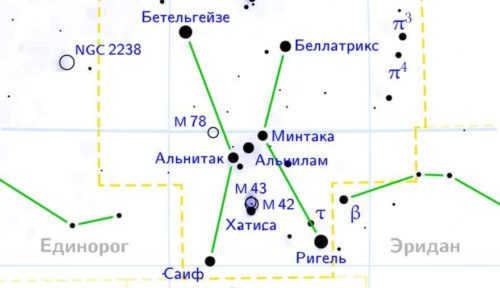
Main stars in the constellation of Orion
The primary stars in the Orion constellation consist of hot massive luminaries. They possess a size and brightness that surpasses that of our Sun by tens and hundreds of thousands of times.
Fascinating fact! The primary stars in the Orion constellation are significantly larger than the Sun, yet much younger. The average age of these celestial bodies is 5-7 million years, while our Sun is 4.5 billion years old.
Betelgeuse, a red supergiant star (M2lab), is at its highest point on the hunter’s right shoulder. It is a variable star that can vary in brightness. When it is cold, it is 80,000 times brighter than the sun, and when it is hot, it is 105,000 times brighter. Betelgeuse has an absolute magnitude of -6.05, making it incredibly large. In fact, it could take up the space from the center of our solar system to the orbit of Jupiter. The giant is located approximately 643 light-years away from Earth. In cosmic terms, Betelgeuse will soon shed its red shell and transform into a white dwarf.
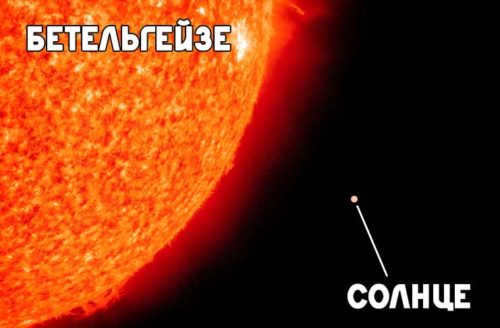
The Star Known as Rigel
Rigel is a blue variable binary supergiant star (B8lab) that is 85,000 to 130,000 times brighter and 75 times larger than the Sun. It is composed of two objects, referred to as “Rigel A” and “Rigel B”, which orbit around a center of mass with a period of 10 Earth days. This star is capable of changing its absolute magnitude from -7.64 to -8.04 astronomical units within a span of 3 weeks. Rigel is located in the constellation Orion and represents the left knee of the hunter, known as Riǧl Ǧawza al-Yusra in Arabic, which translates to “left leg”.
Bellatrix
Bellatrix is a massive white-blue giant star (B2 III) with a remarkable absolute magnitude of -2.8 and a luminosity of 1.59 to 1.64 units. It shines incredibly bright, being approximately 6,400 times brighter than our own Sun, and it weighs nearly 10 times more than our Sun. Located approximately 240 light-years away from Earth, Bellatrix captivates astronomers with its beauty and intriguing nature.
Astronomers have made an interesting observation about Bellatrix – they suggest that this magnificent star is undergoing a fascinating transformation. It is believed that Bellatrix is gradually transitioning into an orange giant, a process that is estimated to take less than 10 million years. This transformation is truly awe-inspiring, as it demonstrates the dynamic nature of the universe and the constant changes that occur within celestial bodies.
Mintaka
Mintaka is a binary star system composed of an O-type star and a B-type star that revolve around a common center of mass every 5.63 days. Situated approximately 900 light-years from our planet, Mintaka boasts a mass 20 times greater than that of the Sun. Within its constellation, Mintaka holds the rank of being the seventh brightest star.
Alnilam
Alnilam is a massive supergiant star that shines with a blue-hot brilliance. It belongs to the spectral class B0 and is approximately 60 times more massive and 375,000 times brighter than our Sun. Situated at a distance of about 1,300 light-years from Earth, Alnilam is a relatively young celestial body, with an estimated age of 4-5 million years. As it continues to evolve, Alnilam will eventually transform into a red supergiant, surpassing the size of Betelgeuse.
The constellation consists of multiple stars, the largest one being the Alnitak A (O9) which is a hot blue supergiant with an absolute magnitude of -5.25 and is located 700 light-years away from Earth. This star system is 28 times more massive than the Sun. Alnitak translates from Arabic as “belt”.
Saif
Saif is a blue supergiant (B0.5) with a size of -6.1 units, situated at a distance of 720 light-years from Earth. It is 17 times more massive and 57,500 times brighter than the Sun. Currently, it is in the phase of undergoing a rebirth into a supernova, which will eventually result in an explosion and transformation into a white dwarf.
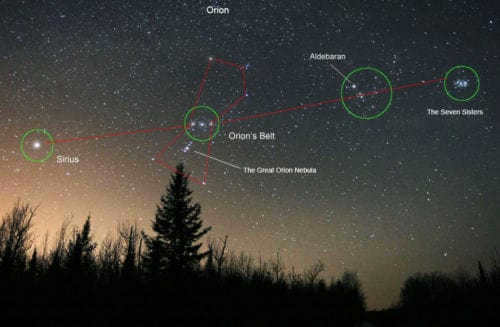
The Constellation’s Celestial Objects
The celestial huntsman is composed of multiple constellations – groupings of stars that define its shape, including a club, a head, a shield (or skin), and a sword. The most well-known ones are:
- The Sheaf – representing the outline of the huntsman’s figure, formed by the stars: – α (Betelgeuse), β (Rigel), γ (Bellatrix), ζ (Alnitak), η (Mintaka), κ (Saif).
- Orion’s Belt – comprised of 3 bright stars: ε (Alnilam), ζ (Alnitak), η (Mintaka), positioned in the same plane and equidistant from each other.
- Orion’s Shield (or Skin) – an asterism of 6 stars: π1, π2, π3, π4, π5, and π6.
- Orion’s Baton – an asterism of 5 stars: χ2, χ1, ν, ξ, and 69.
- The Sword of Orion consists of two stars, θ and ι, as well as the Great Orion Nebula.
- Within the M42 nebula, you can find Orion’s Trapezium, a dense cluster of stars.
- Located in the Hunter’s Sword region, the Orion Nebula (M42 or NGC1976) is the largest collection of interstellar hydrogen clouds.
Even in a brightly lit city, certain celestial objects and areas can still be visible in the night sky. With the aid of binoculars or a telescope, you’ll be astounded by the ethereal glow surrounding the “sword” region.
Interesting facts about the Orion constellation
The celestial hunter has had a significant impact on human life. The ancient cultures had a deep understanding of the night sky, as evidenced by their beliefs and practices. Here are a few fascinating facts that highlight the importance of Orion to the equatorial population of Earth:
- The Hopi Indian tribes from Northeastern Arizona still believe that their deities reside on the planet Pi-3 (π3) in the northern part of the Orion constellation.
- The three main pyramids of Egypt were constructed in alignment with Orion’s Belt, creating a mirrored image.
- The Mayan civilization worshipped the gods associated with this constellation, which is evident in the positioning of the Moon, Sun, and Mayan god temples.
- Michelangelo chose to incorporate the Orion Trapezium constellations into his paintings and frescoes of cathedrals, faithfully depicting their arrangement as observed from Earth;
- Many enthusiasts of ufology speculate that extraterrestrial beings come to Earth from the Orion constellation due to its breathtaking beauty.
The Orion constellation consists of approximately 2,770 stars. Russians have the opportunity to marvel at the celestial objects of this hunter from early December until the end of March.
Orion: Beyond a Constellation. Evil Cosmos Channel:
It is interesting to note that Orion is widely recognized as one of the most renowned constellations in the night sky. What makes it even more fascinating is the fact that it is situated along the celestial equator, placing it within the equatorial regions. In terms of its ranking, Orion holds the 26th position on the list of constellations. Scientists have determined that it covers an area of approximately 594 square degrees. Additionally, it is worth mentioning that in close proximity to Orion, one can find other notable constellations such as Gemini, Unicorn, Hare, Taurus, and Eridanus.
During the time of ancient Greece, numerous myths abounded. One particular legend tells the tale of a hunter residing in Thebes. This hunter possessed exceptional looks, a commanding presence, and an impressive stature. On occasion, due to his tremendous height, he was even referred to as a giant. This legendary figure was known as Orion. It is believed that the constellation Orion is directly linked to the existence of this mythical hunter.
The Origin of Orion
The origin or birth of Orion is a topic of great confusion. While there are multiple versions, let’s focus on the main one.
According to myth, Orion is believed to be the son of Poseidon, the god of the sea. In ancient Greek times, when the gods walked among humans and performed miraculous feats, a fascinating story unfolded.
The tale begins with the three mighty Greek gods – Zeus, Hermes, and Poseidon – venturing into the city of Thebes. During their visit to a certain Giriye, they offered a bull as a sacrifice and indulged in its meat.
The gods paid close attention to him and requested that he retrieve the hide of the bull. After attentively hearing him out, the gods instructed him to fetch the hide from the bull, which they had deemed an acceptable sacrifice. They proceeded to fill the bull’s hide with urine and directed him to bury it. A while later, Orion came into existence. It is rumored that Orion was bestowed with the ability to walk on water by his father, Poseidon.
Orion’s Journey
Orion, a formidable hunter known for his strength and bravery, had the companionship of two loyal dogs, Big Dog and Little Dog.
As life carried on, Orion made the decision to enter into marriage. It was Merope who caught his attention, captivating him with her beauty. However, Merope’s father, Oenopion, proposed a condition. In order to marry his daughter, Orion had to rid the island of Chios of its predatory wild animals. Eager to wed, Orion wholeheartedly accepted the challenge and successfully completed his task.
However, Oenopion did not fulfill his end of the agreement and continuously postponed the wedding. Frustrated by this betrayal, Orion took matters into his own hands and forcefully took Merope as his bride. This act of defiance greatly angered Merope’s father, who, in a fit of rage, blinded the once mighty hunter.
Orion accomplished various tasks during his time in Sicily, including the construction of an embankment and a port. Subsequently, he relocated to Euboea.
The Demise of Orion
The death of Orion is shrouded in mysteries and surrounded by countless myths. The abundance of tales is so vast that one could write an entire article without uncovering the truth.
As the saying goes, “Different folks, different strokes,” and this sentiment holds true for the numerous myths surrounding Orion’s demise. However, despite the diversity of these stories, many cultures share a common narrative.
According to one account, Orion met his demise after being stung by a scorpion. The identity of the perpetrator of this heinous crime remains a subject of debate. Some believe that Gaea or Poseidon sent the scorpion.
Another version of the myth suggests that Gaia originally intended for the scorpion to bite Artemis, but due to a mix-up, Orion was the one who suffered the venomous sting.
The constellation of Orion is not only fascinating, but it is also accompanied by a peculiar legend. Additionally, according to mythology, Orion left behind two daughters and 50 sons.
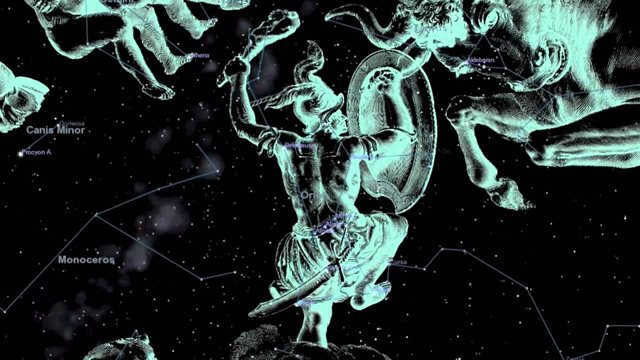
The star Orion belongs to the Orion constellation
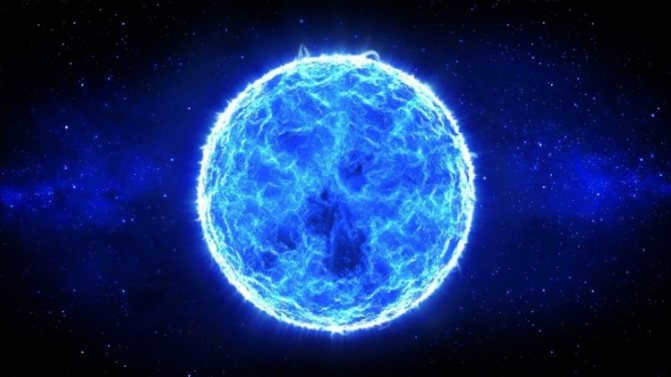
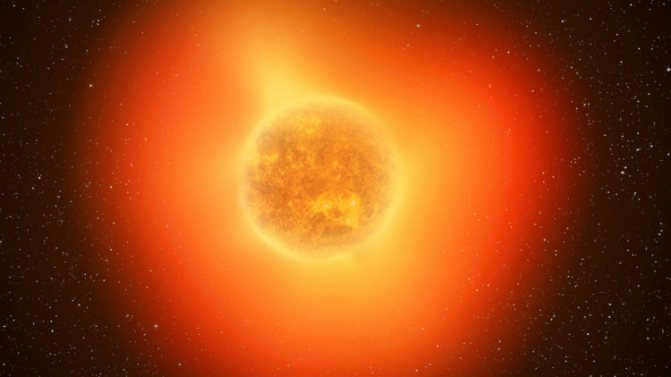
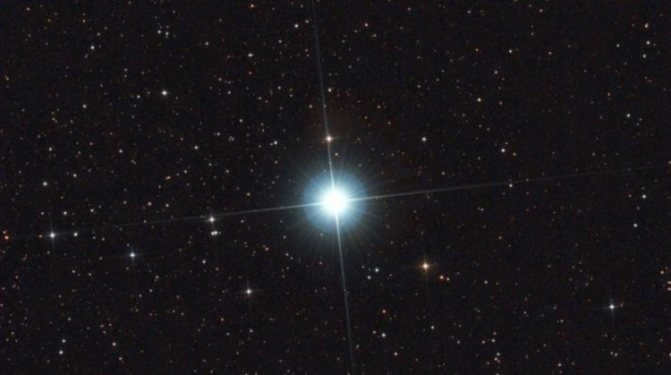
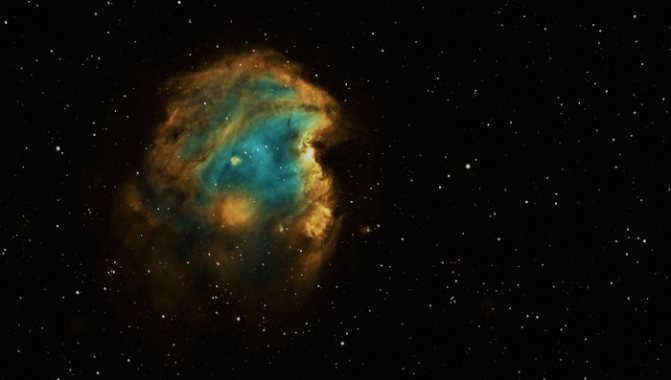
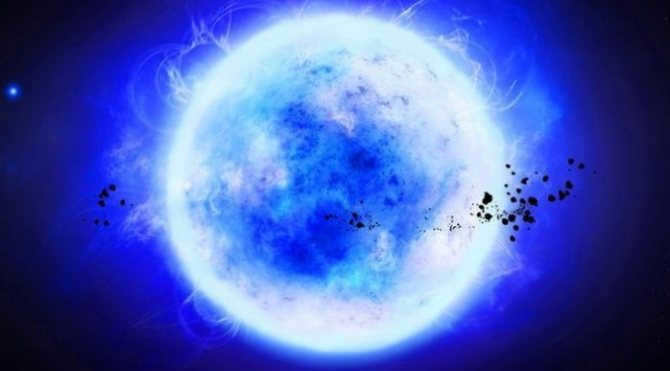
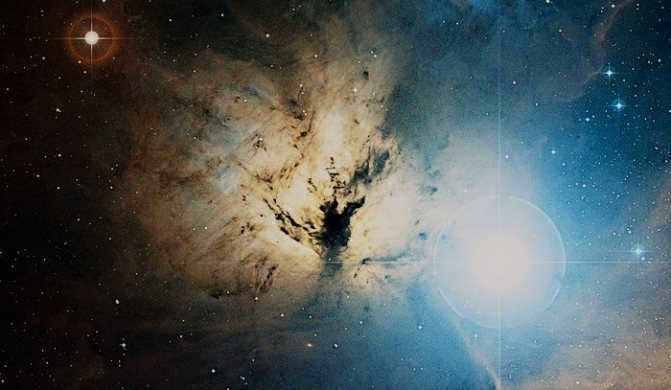
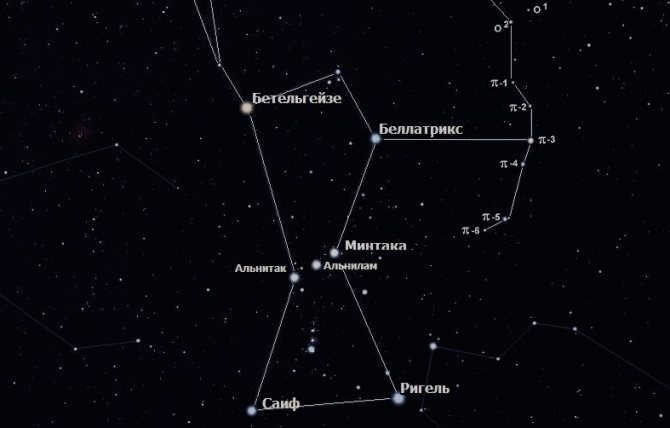
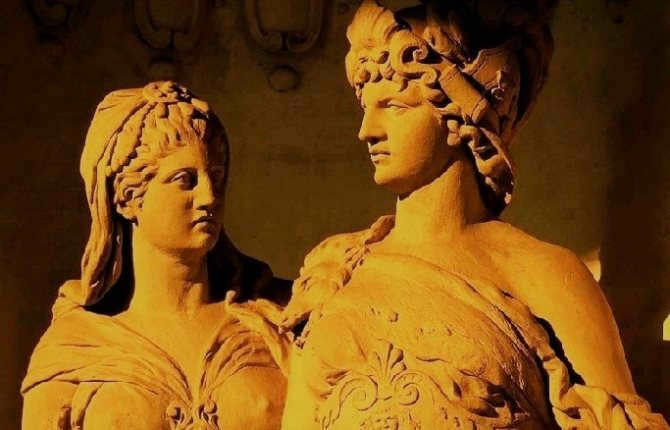
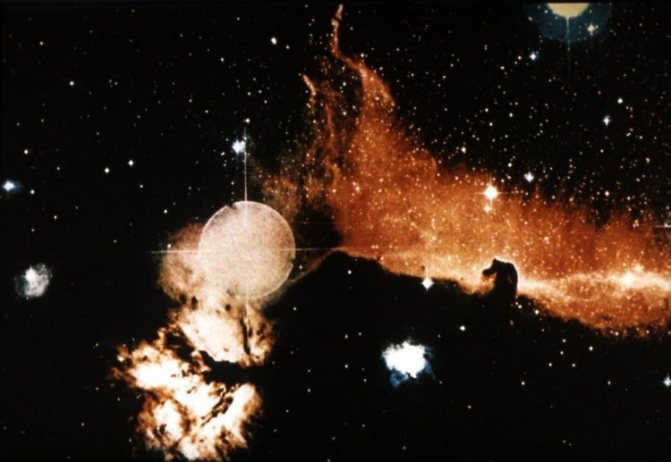
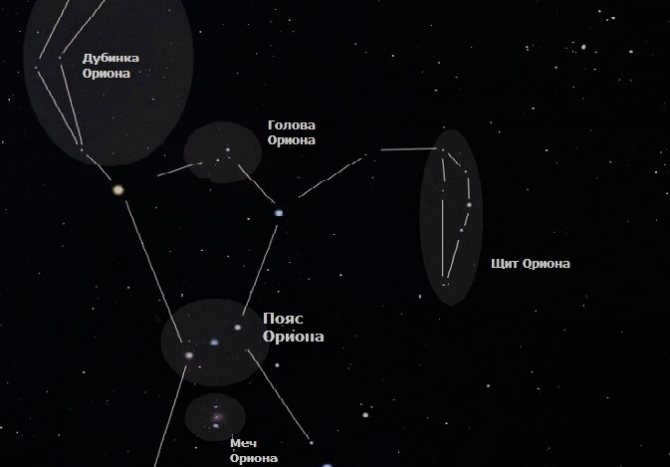
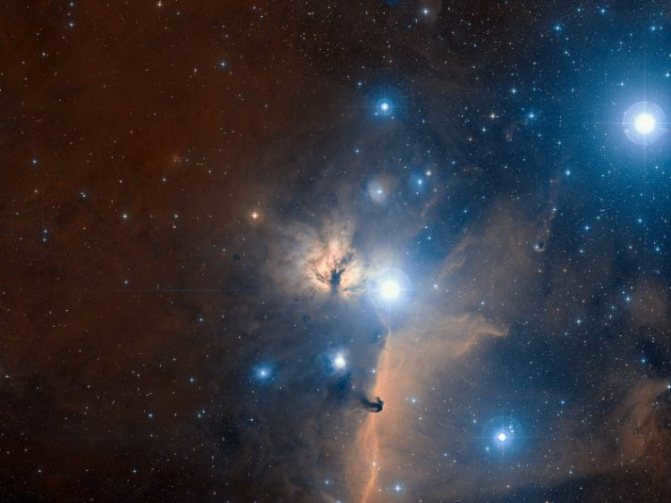
According to ancient Greek myths and legends, Orion was born to Poseidon, the god of the seas and oceans, and Euryale, one of the Gorgon sisters. As he grew older, he embarked on a journey and came across a city where he instantly fell in love with Princess Merope, the daughter of King Oinopion. Determined to marry her, Orion approached the king and asked for his daughter’s hand in marriage. However, despite his renowned beauty and hunting skills, his request was denied. The king was unwilling to give up his beloved daughter. Frustrated, Orion decided to forcibly take the princess, but when King Oinopion learned of his intentions, he captured and blinded the young man before casting him onto the shores of the sea.
Thanks to the guidance of the oracle, Orion was able to regain his health and his vision. Filled with a desire for revenge against the king, he set out on a journey to find him. However, fate had other plans for Orion, as he encountered the stunning Artemis during his travels and instantly fell in love with her. The goddess of the hunt felt the same way, and their love blossomed.
Unfortunately, Orion had a tendency to boast about his hunting skills, claiming that he was the greatest hunter of all. This arrogance did not sit well with the goddess Hera, wife of Zeus, who held a grudge against the young man. In her wrath, she sent a deadly scorpion to kill Orion with its venomous sting.
Artemis was devastated by the loss of her beloved and mourned for a long time. Eventually, she decided to honor him by immortalizing him as a constellation in the night sky. Now, Orion shines brightly every night, pleasing his beloved goddess. In retaliation, Hera placed the constellation Scorpio on the opposite side of the sky, ensuring that the two constellations would never rise together.
Descriptions
The Orion constellation is a stunning and unforgettable sight in the night sky. So, what exactly does the Orion constellation look like?
With a total of 209 stars visible to the naked eye, the Orion constellation forms the shape of a hunter holding a sword and shield.
Among the stars in the constellation, there are three that stand out. These blue-white stars are situated close to each other and appear almost in a straight line. They are commonly referred to as Orion’s Belt, and are also known as the Three Kings or the Three Magi.
Incidentally, the constellation Orion and the star Sirius are situated in close proximity within the constellation of Canis Major, and it is quite effortless to locate the brightest star by using Orion as a reference point. To be precise, by mentally connecting three luminous stars and extending a line towards the southeast direction, we will come across a brilliant star. Rest assured, you will not mistake Sirius for anything else.
The constellation of Orion is abundant in radiant and exquisite stars. Let us now delve into the most prominent and renowned stars within the constellation of Orion.
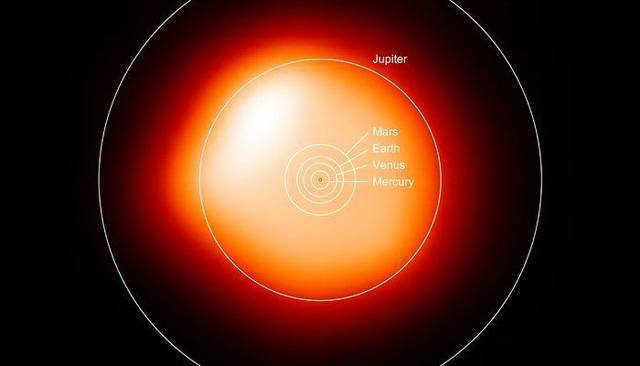

If Betelgeuse were placed in the Sun’s position, it would entirely occupy the orbit of Jupiter
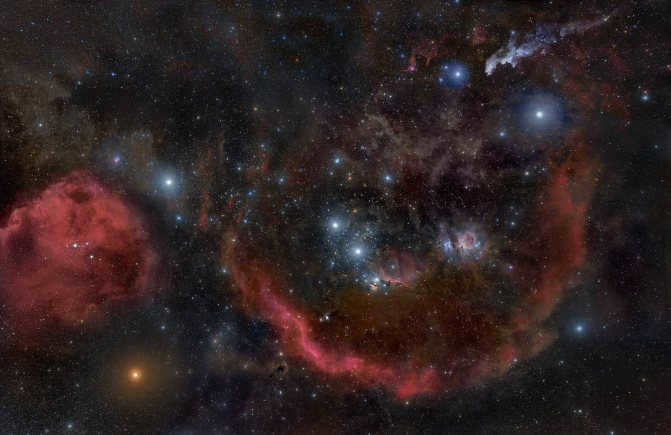
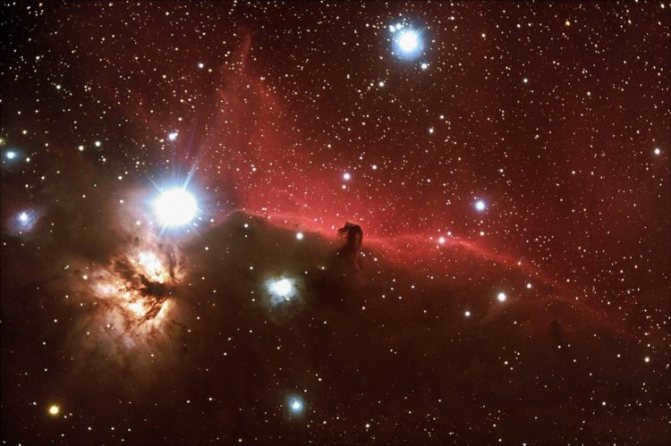
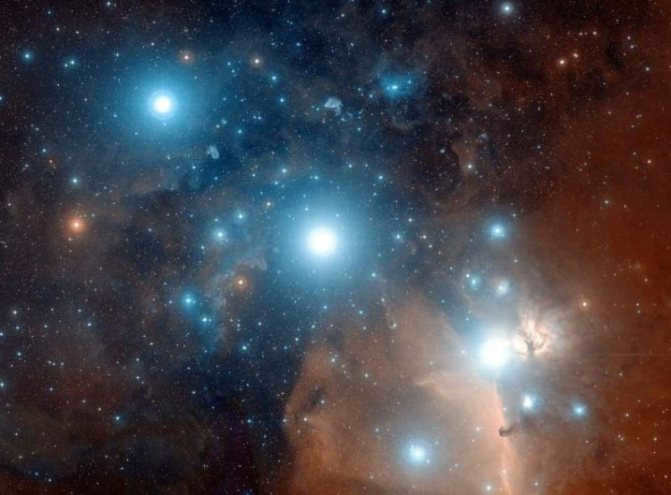
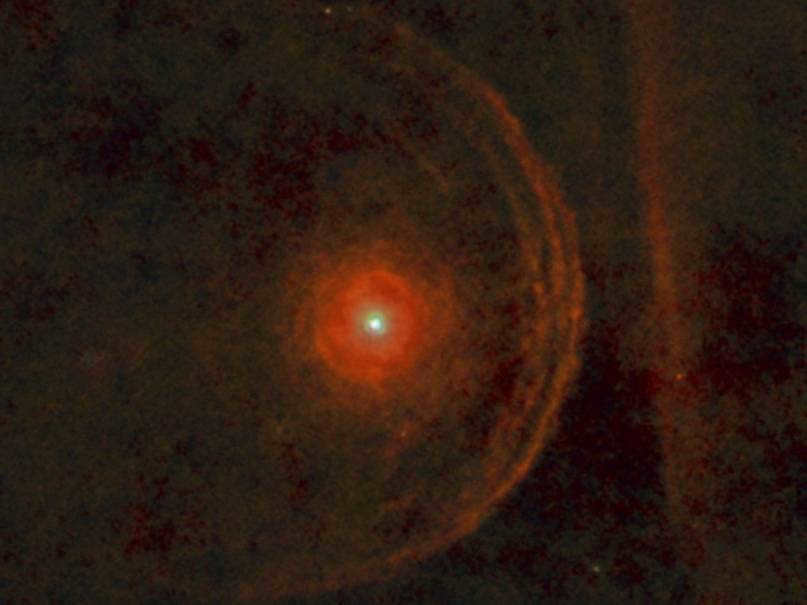
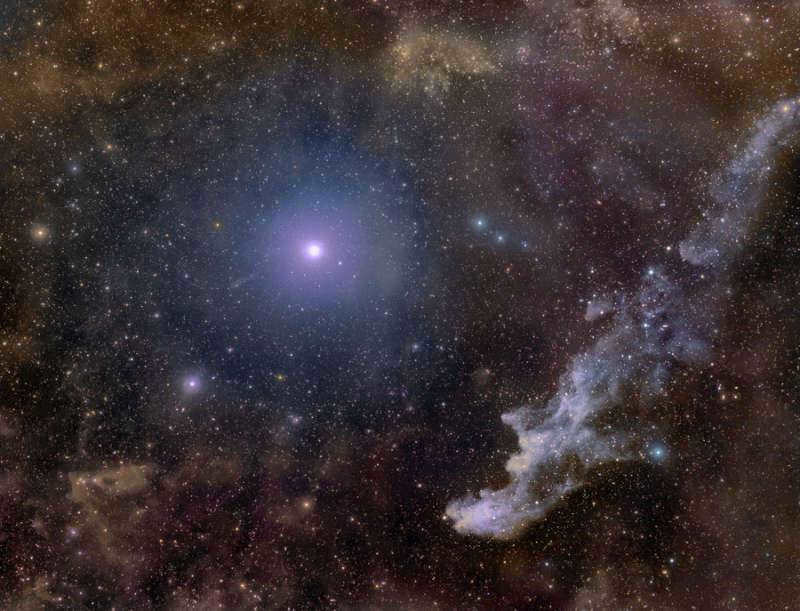
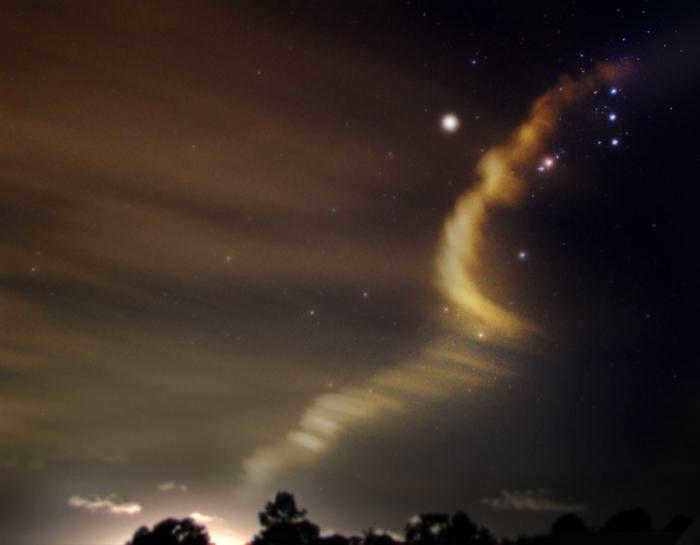
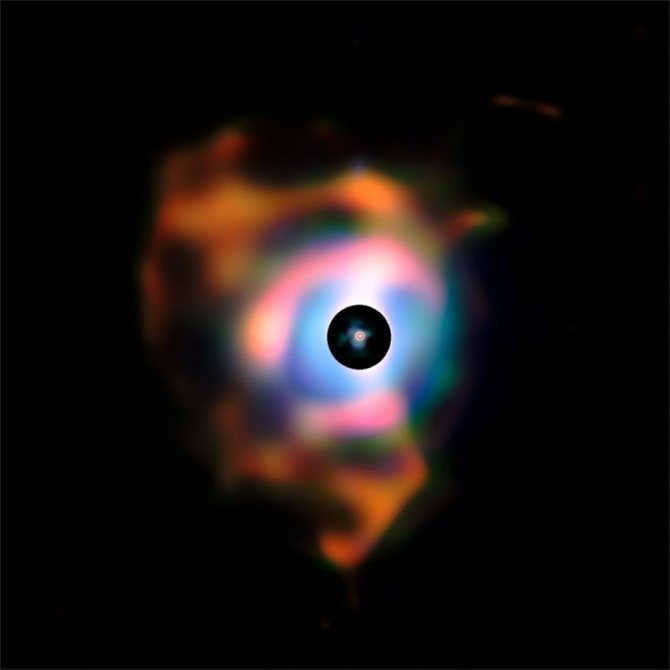
Background
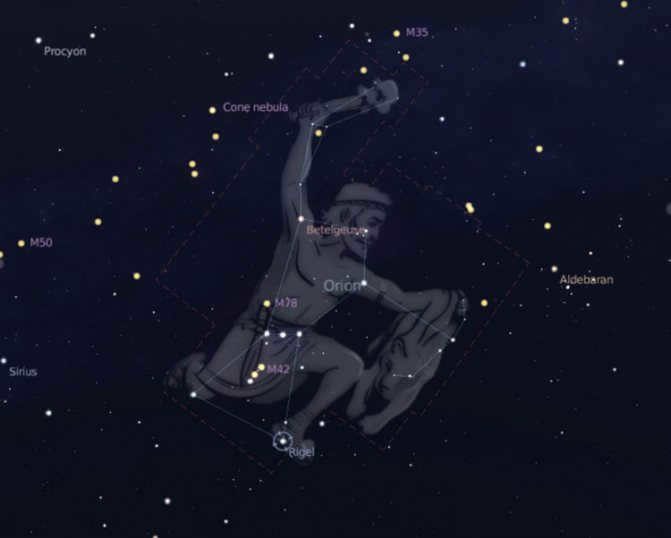
In ancient Greece, the constellation Orion was believed to represent the great hunter Orion, who was said to be the son of Poseidon and Euryale. Poseidon placed Orion in the sky after he died from the arrows of the goddess Artemis (in another version of the myth, he died from the bite of Scorpio).
In ancient Russia, the constellation was known as Kruzhiliya or Kolo. In Armenia, the constellation of Orion is called Hayk, in honor of the patriarch and ancestor of the Armenians. According to traditional beliefs, Hayk’s soul ascended and became frozen in the sky, forming the constellation that bears his name.
The Incas named the constellation Chakra, while they called Orion’s belt Pata, meaning “Captured”. This was because they believed that the Moon sent the two outer stars to capture the middle star, which was seen as a thief and criminal. These stars were then handed over to the “Vultures”, which are the four stars below and above in the constellation.
On a ceramic vessel from the Vucedolian culture discovered near the Croatian town of Vinkovci (3000-2600 BC), we can see depictions of Orion, the Sun, Cassiopeia, Swan, Gemini, Pegasus, and Pleiades.
Stars in the constellation
Rigel star
The star Rigel can be found in the constellation Orion. Its name translates to “foot” in English. When observing the constellation, Rigel appears as the lower right-hand star, creating a shape that resembles an hourglass. In the context of Orion, Rigel represents the left leg or heel of the hunter. Rigel is an impressive star, both in size and brightness. It is approximately 800 light years away from the Sun and is 75 times larger and 130,000 times more luminous than the Sun. Rigel is the nearest star to us with such a remarkable luminosity. In ancient Egypt, this star held great significance and was associated with Osiris, the god of the afterlife.
The red giant star Betelgeuse in the constellation Orion
Betelgeuse, a prominent star in the constellation Orion, is known for its distinctive red color. It derives its name from the Arabic phrase “yad al-jawzā,” which means “hand of the central one.”
Located in the upper left region of the hourglass-shaped Orion constellation, Betelgeuse also serves as the right shoulder of the celestial hunter. Its position within the constellation makes it easily recognizable.
One of the notable characteristics of Betelgeuse is its variability in luminosity. This means that its brightness constantly changes over time. At its minimum, Betelgeuse is approximately 80,000 times brighter than the Sun, while at its maximum, it can reach up to 105,000 times the Sun’s brightness.
In addition to its variable luminosity, Betelgeuse is also an exceptionally large star. If it were placed in the Sun’s position, it would extend beyond the orbit of Jupiter, which is the fifth planet from the Sun. This gives an indication of the immense size of Betelgeuse.
With a mass 15 times greater than that of the Sun, Betelgeuse is located approximately 550 light years away from Earth. Its distant location adds to the awe-inspiring nature of this celestial giant.
Observing the star Bellatrix can be a fascinating experience due to its unique characteristics. This star is a variable red giant, meaning that its future holds either a supernova explosion or a transformation into a white dwarf. The exact timing of this event remains uncertain, but when it does occur, it promises to be a truly magnificent spectacle.
Exploring the Star Bellatrix
Located in the constellation Orion, Bellatrix is an intriguing blue-white giant. This star is known by various names, including Amazon, Conqueror, Warrior, and Lion’s Roar.
If we direct our gaze toward the hunter, Bellatrix can be found near the bicep of the left arm in the top-right region of the hourglass formation.
Ranked as the 26th brightest star, Bellatrix was also one of the celestial bodies relied upon for navigation in ancient times.
Bellatrix, which is 4,000 times more luminous than the Sun and 6 times larger and 10 times more massive, is a significantly sizable star. However, despite its considerable size, Bellatrix is also remarkably youthful, with an age of approximately 20 million years. Despite its relatively young age, Bellatrix is rapidly consuming its fuel, and in a few million years, it will undergo a transformation into a red giant, and subsequently either a supernova or a white dwarf.
Alnilam: The Brilliant Star in Orion
Alnilam, the dazzling blue supergiant, resides in the famous constellation Orion. Its name, which means “thread of pearls,” perfectly captures its majestic beauty. Alnilam is part of the iconic hunter’s belt, composed of three prominent stars, with Alnilam positioned in the center. Standing as the 30th brightest and fourth brightest star in Orion, Alnilam holds a special place among the 58 stars that ancient sailors relied on for navigation.
With an estimated age of 4-106 years, Alnilam’s future is equally captivating. In the coming million years, this stellar wonder will undergo a remarkable transformation, evolving into either a red giant, a supernova, or even a white dwarf.
The star Alnitak
Alnitak is a star system located in the extreme bottom of Orion’s belt. It is composed of three stars, with the dominant one being the blue supergiant Alnitak A. The other two stars in the system are also blue but smaller in size. Notably, Alnitak A is 20 times larger than the Sun.
The star Saif
Saif is an intriguing star located southeast of Orion’s belt, specifically at the hunter’s knee. It is a blue-white star that is 22 times larger than the Sun. Its luminosity surpasses that of the Sun by a staggering 57,500 times, making it a fascinating object to observe.
Mintaka, situated on the far right of Orion’s belt, is an extraordinary blue supergiant. Being a multiple star system, Mintaka boasts two or more stars. Though invisible to the naked eye, a telescope reveals the magnificent sight of two or even three stars. Undoubtedly, Mintaka presents a captivating subject for observation.
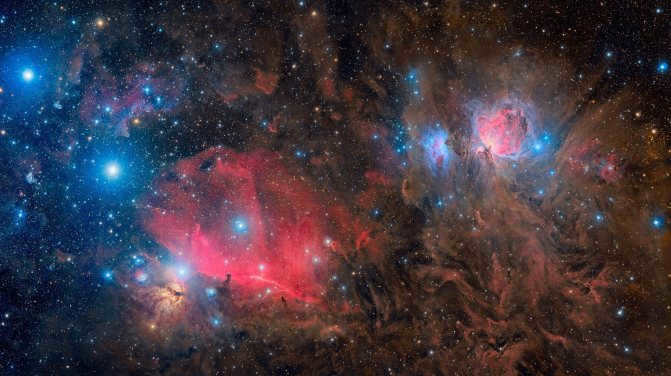
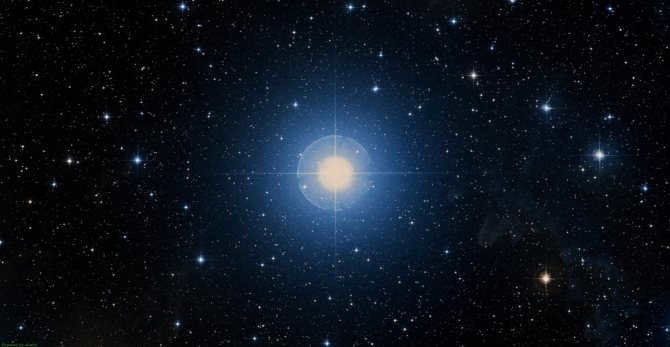
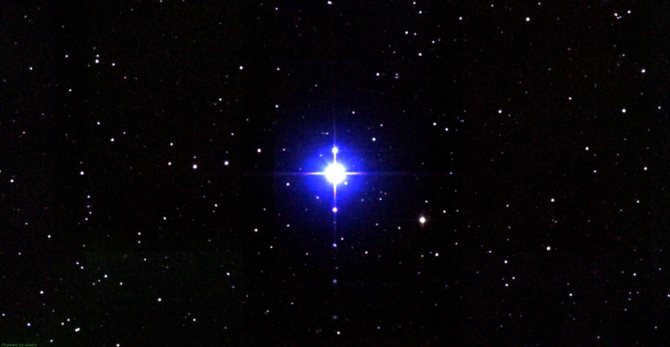
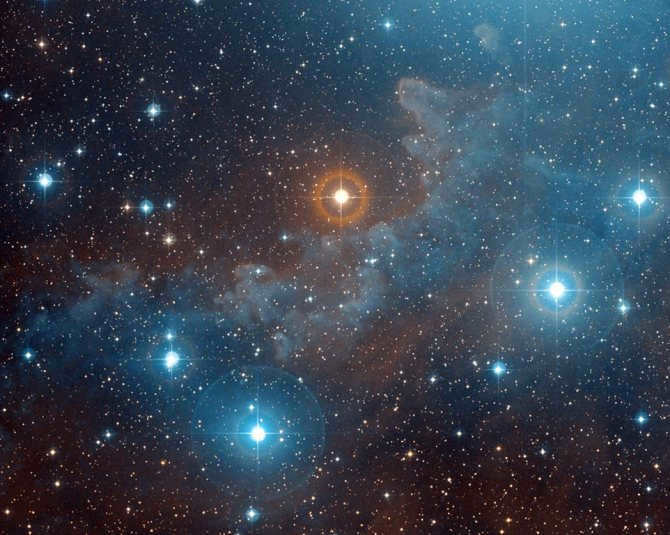
The star Orion
Recently, the map of the Orion constellation has been updated with the addition of another fascinating entity situated near the Trapezium. Research has revealed that throughout the evolution of the M42 nebula, numerous star collisions occurred, potentially leading to the creation of a black hole that surpasses the Sun in mass by a factor of one hundred. This hypothesis aligns perfectly with the observations of the high velocities exhibited by the stars comprising the Orion Trapezium. Should the existence of a black hole be validated, it would represent the nearest object of its kind to our solar system.
Asterisms
Asterisms refer to a collection of stars that are easily identifiable and have their own unique names.
We have previously mentioned the sheaf or butterfly asterism, which also resembles an hourglass.
Orion’s Belt is a well-known asterism, also known as the Three Kings or the Three Magi.
The Sword of Orion, an asterism that hangs from the hunter’s belt and consists of two stars and a nebula.
The Shield of Orion, another famous asterism that consists of six stars.
Orion’s Baton, an asterism held in the hunter’s right hand above him, featuring five stars.
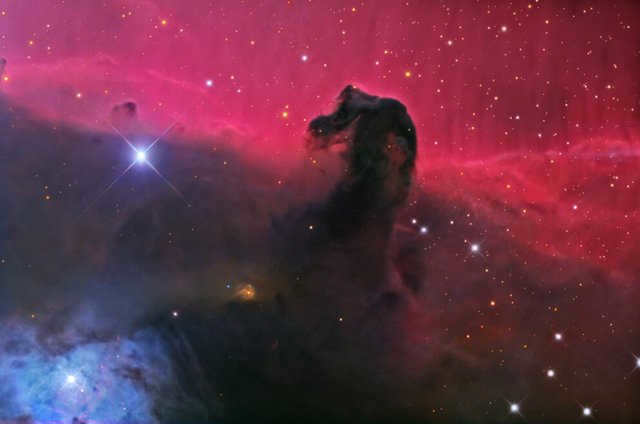

The celestial object known as the Horsehead Nebula is located in the constellation of Orion. It is a stunning sight in the night sky, captivating astronomers and stargazers alike. Its distinct shape resembles that of a horse’s head, hence the name. This nebula is a dark cloud of gas and dust, illuminated by nearby stars. Its beauty and mystery make it a popular subject of study and admiration for those who venture into the depths of space.
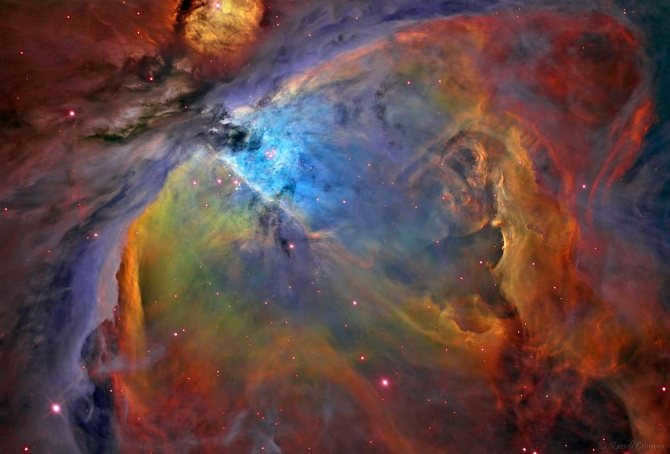
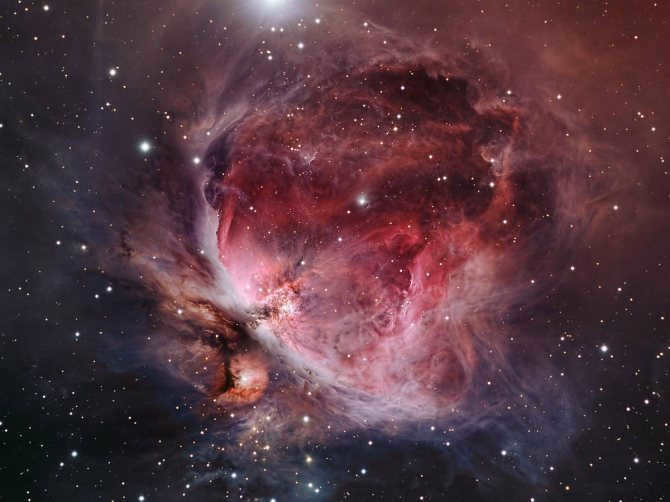
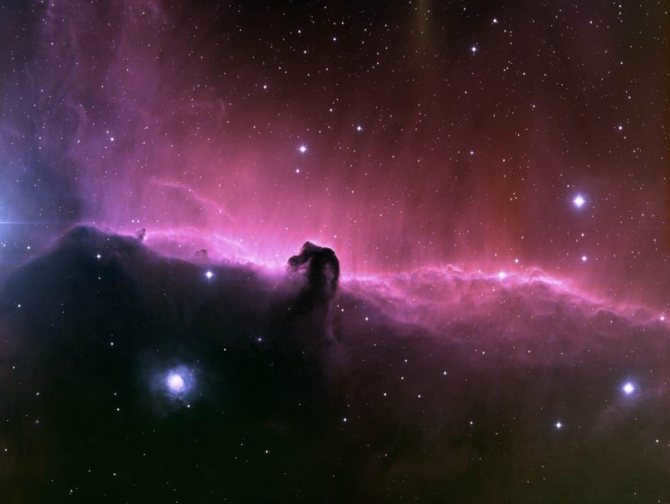
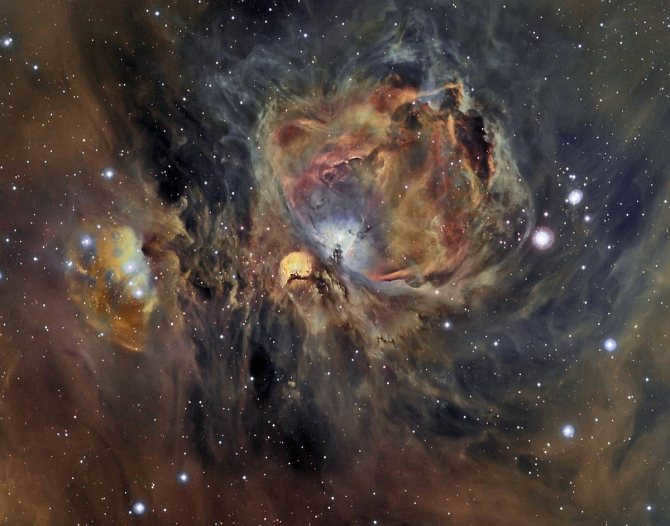
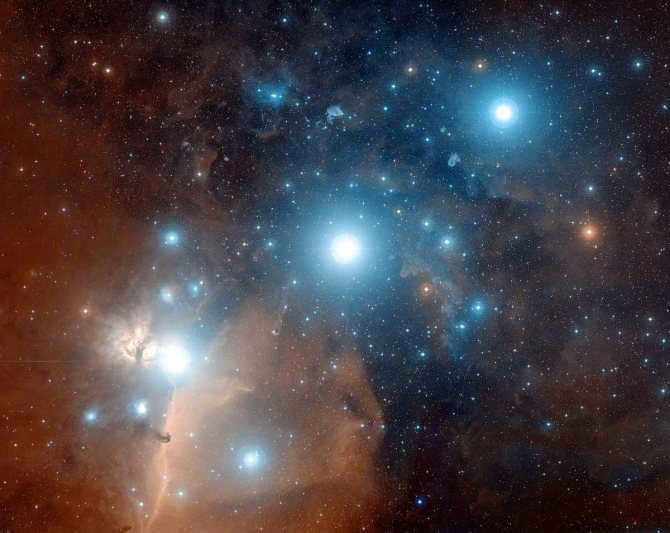
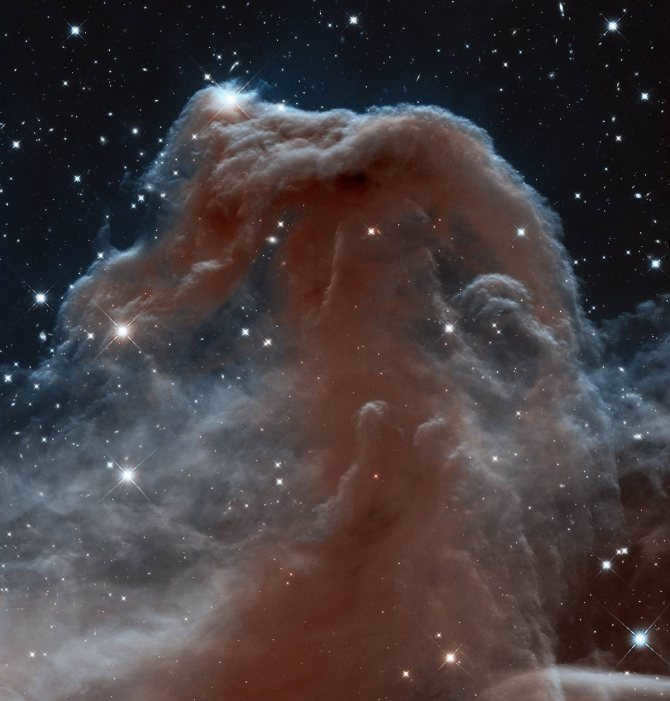
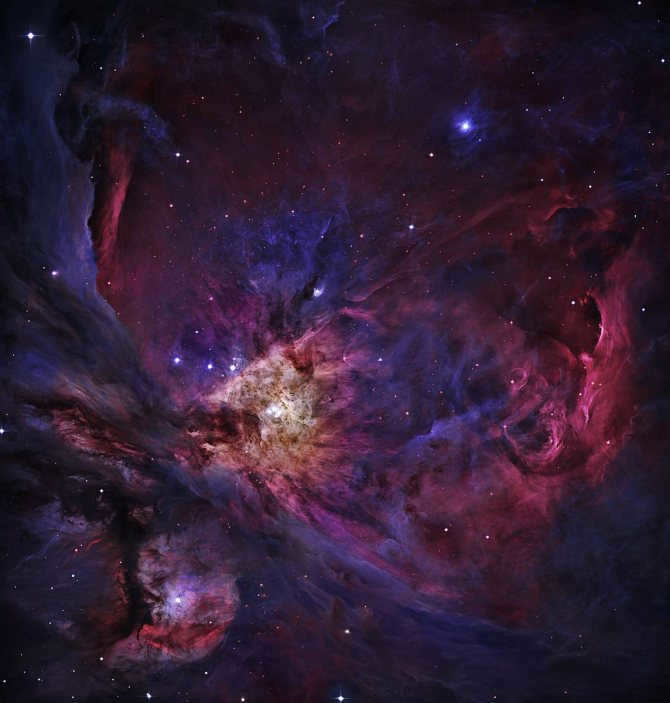
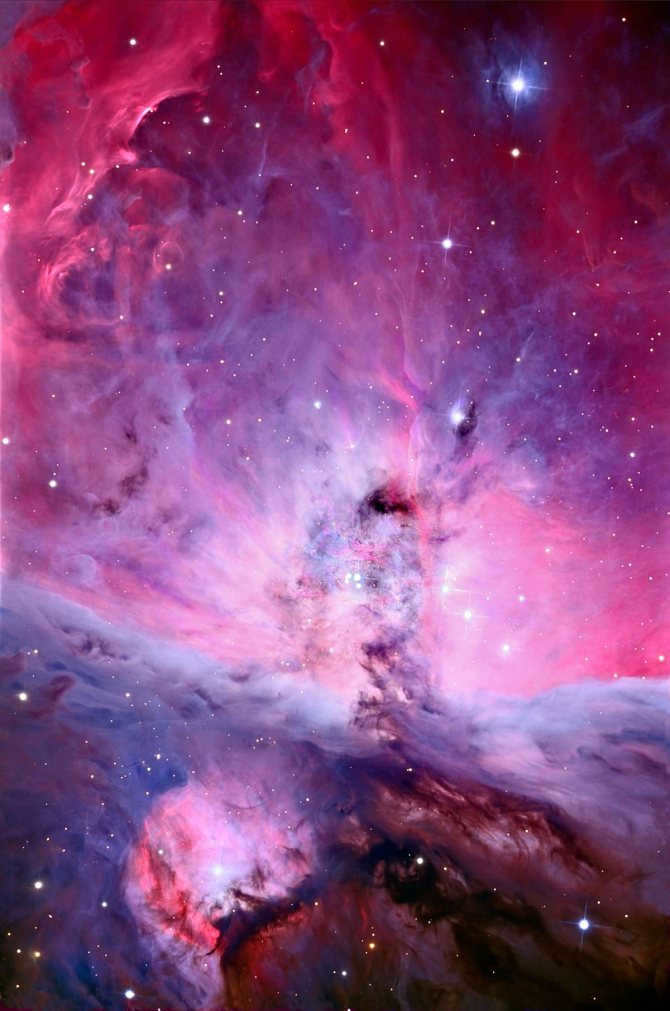
Nebulae and Star Clusters in the Constellation of Orion
The constellation of Orion boasts a plethora of fascinating objects including star clusters and nebulae. Let’s delve deeper into this celestial wonderland.
One remarkable nebula in Orion is M43, also known as de Merana or NGC 1982. This emission nebula serves as a breeding ground for new stars.
Located within the hunter’s sword, M43 forms a distinctive comma shape within the constellation.
Renowned for its beauty, M43 is best observed in Russia during the winter months.
Another well-known object in Orion is the Horsehead Nebula (IC 434). Situated near Orion’s belt, specifically next to the leftmost star Alnitak A, IC 434 appears like the silhouette of a dark horse’s head set against a vibrant red backdrop. This captivating sight is a true feast for the eyes.
Orion’s Cloud
The Orion cloud is worthy of particular scrutiny. It encompasses a remarkably vast expanse, spanning several hundred light years. The Orion cloud comprises numerous distinct entities, including M42, M43, M78, the Horsehead Nebula, Barnard’s Loop, NGC 2024 (Flame Nebula), NGC 1973, NGC 1975, and NGC 1977. This presents an exceptional opportunity for observation.
Stallion Head
Animal-like shapes can be found not only in constellations in the sky. Another well-known nebula called the Horsehead (or B33) resembles the shape of a horse’s head. The clear outline of the Horsehead nebula is thanks to the illumination provided by another nebula that acts as a backdrop. B33 itself does not emit light, making it an absorbing nebula. Without a bright background, it would be difficult to see. However, not every device is able to detect it under the current conditions. The “Horsehead” has become a marker of the equipment’s functionality and accuracy.
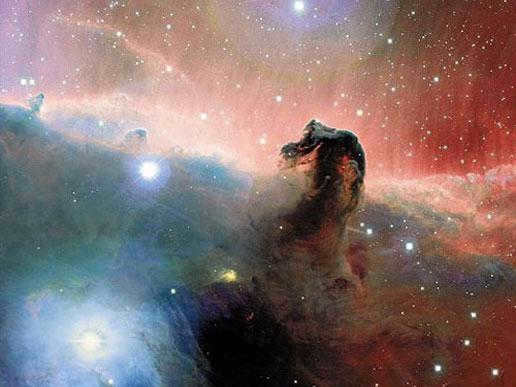
Locating the constellation Orion
As previously mentioned, the optimal period for observing Orion in Russia is during the fall and winter seasons. The visibility of the constellation varies depending on the location and month of observation. The most favorable months are from November to January. In November, Orion can be seen rising in the late evening.
In the night sky, you can easily spot this renowned constellation. It is recognizable by its three prominent stars that form a line – known as Orion’s belt.
On the top left, you will find the red star Betelgeuse, while the white star Rigel is located on the bottom right. Orion’s belt is situated in the middle. Make sure to locate this constellation and witness its extraordinary beauty.
Notes
- ↑ 12
Orion // The Great Soviet Encyclopedia / Editor-in-Chief B. A. Vvedensky. – Moscow: Soviet Encyclopedia, 1955. – VOL. 31. – P. 193. - Hesiod. Catalogue of Women, fr. 148a M.-U. = Pseudo-Eratosthenes. Catasterisms 32; Hyginus. Astronomy II 34, 1
- Palefat.
[ancientrome.ru/antlitr/palaephatus/transl-p.htm On the improbable. Notes]. - Nonnus. Acts of Dionysus XLVIII 418
- ↑ 123Takho-Godi A. A.
Orion // Mythological Dictionary / ed. by E. M. Meletinsky. – Moscow: Soviet Encyclopedia, 1990. – ISBN 5-85270-032-0. - First Vatican Mythograph I 32, 1-2
- Hyginus. Mythos 195; Antoninus Liberalus. Metamorphoses 25, 1
- Pindar, fr. 73 Bergk (dithyramb about Orion)
- Strabo. Geography X 1, 4 (p. 446)
- [thelema.su/majer-atalanta-fugiens/ Michael Mayer. Escaping Atalanta 93 in 39]
- Pseudo-Apollodorus. Mythological Library. Book I.
- Ovid. The Science of Love I 731
- Pseudo-Apollodorus. Mythological Library I 4, 3
- Parthenius. On the passions of love 20
- Hesiod. Enumeration of Women, ff. 149 M.-U.
- Diodorus of Sicily. Historical Library IV 85, 1.5-6; Pseudo-Eratosthenes. Catasterisms 32
- Pindar
. Nemean Songs II 11-12. - Pindar
. Fr. 74 Bergk - Hyginus
. Astronomy. II 21, 4. - The first Vatican mythographer. III 32, 6-7.
- Lubker F.
A complete dictionary of classical antiquities. – Moscow, 2001. – VOL. 3. – P. 104. - Orion (mythology)
– Article from the Big Soviet Encyclopedia. - [Pleiades Orion (mythology)].
– article from the encyclopedia “Krugosvet” - Saplin A. Ю.
Pleiades // Astrology for everyone. Encyclopedia / A. Yu. Saplin. – Moscow: Geleos, 2007. – ISBN 978-5-8189-0996-7. - Nonn
. Acts of Dionysus. IV 341-346. - Nonn
. The Acts of Dionysus . IV 193. - Homer
. Odyssey. V 121-124. - Pseudo-Apollodorus
. Mythological Library. I 4, 3-5. - Horace
. Odes III 4, 71-72. - Hyginus
. Astronomy. II 34, 3, with reference to Istra. - Hesiod
. Enumeration of Women, ff. 148a M.-U. =
Pseudo-Eratosthenes
. Catasterisms. 32. - Aratus
. Apparitions 637-646. - Pseudo-Eratosthenes
. Catasterisms. 7. - Palefat
. On the improbable. 51. - Hyginus
. Astronomy. II 34, 2. - Hyginus
. Astronomy. II 26. - Cf. Lucan
. Pharsalia. IX 836. - Ovid
. Fasts. V 537-544. - Sextus Empiricus
. Against the scholars. I 262. - Pausanias
. Description of Hellas. IX 20, 3. - Antoninus Liberalus
. Metamorphoses. 25, 1. - Corinna
. Fr. 1-2 Page
The enigmatic nature of Orion’s constellation
The constellation of Orion holds a great deal of intrigue due to its uncanny resemblance to the shape of the Kola Peninsula and the coast of the White Sea. Interestingly, the terrain of the Kola Peninsula is adorned with man-made labyrinths and sanctuaries that align with the constellation.
Legend has it that the Hyperboreans, a mythical civilization steeped in ancient Greek traditions, resided in the northern reaches of Hyperborea.
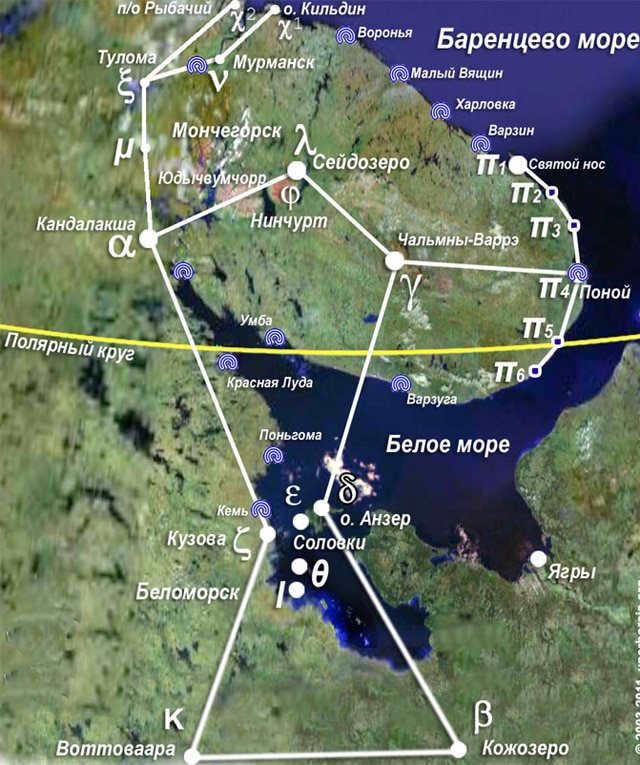
Murmansk region and the constellation Orion
According to the myths of ancient Greece, the Hyperboreans are the successors of the ancient Titans, and even Apollo himself visited this enigmatic civilization in his chariot on multiple occasions.
In 2005, a team of international scientists, considering all the scientific expeditions conducted to the northern regions of Russia, made numerous fascinating discoveries. If you are curious, you can read about it. It is all quite intriguing and then you can decide whether to believe it or not. Although it all appears quite feasible.
Demise of a Hero
For a considerable length of time, Orion roamed the Earth in solitude, desperately searching for someone who could restore his vision. Eventually, he encountered one of the Cyclopes, who took pity on him and guided him to Helios. The mighty sun god possessed the power to restore the hero’s sight. Without much hesitation, Orion returned to his cherished pastime. While in pursuit of prey, he caught the attention of Artemis, the goddess who adored the hunt herself. Orion swiftly became her paramour, much to the dismay of Apollo, the goddess’ brother. Apollo, driven by jealousy, devised a cunning plan to bring about the hunter’s downfall. Aware of Artemis’ pride, Apollo casually questioned her accuracy with a bow and arrow. To put her skills to the test, he proposed that she attempt to hit a distant dark spot, glimmering on the surface of the sea. Unbeknownst to the goddess, the spot was none other than Orion’s head, as he decided to take a swim.

